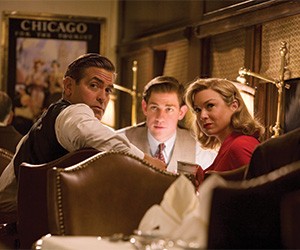In North and South Carolina, what goes for filmmakers also goes for meeting planners, with both states deep in natural, human and technical resources, and from the coast to the mountains, abundant venue and location variety. For groups, this cinematic crossover produces equal possibilities for memorable meetings.
North Carolina
In 1983, seeking an authentic Southern plantation for his adaption of Stephen King’s Firestarter, producer Frank Capra Jr. discovered historic Orton Plantation near Wilmington, N.C. His find ignited North Carolina’s modern film industry—with Wilmington at its center.
Subsequently attracting legendary filmmaker Dino De Laurentiis and film production company EUE/Screen Gems, the destination, also known as “Hollywood East” or “Wilmywood,” has racked up nearly 400 production credits, including movies Blue Velvet and We’re the Millers, and TV’s Dawson’s Creek and Sleepy Hollow.
While the tax credit that propelled North Carolina’s film industry was converted to a less-rewarding grant program in 2015, Wilmington, home to EUE/Screen Gems’ 10 sound stages, leading producers and managers, and 1,000-plus film technicians, remains an active center of production.
“Other strengths include having generic locations that can double for many parts of the country during all seasons,” said Johnny Griffin, director of the Wilmington Film Commission. “Along with our beaches, restaurants and laid-back lifestyle, Wilmington’s filming locations are visitor draws.”
These include group-ready coordinates such as the Wilmington Convention Center (Iron Man 3), Battleship North Carolina (Sleepy Hollow), and 67-acre coastal botanical paradise Airlie Gardens, hosting outdoor events for 450-plus people.
Enduring fandom for TV’s One Tree Hill, shot at Airlie and around Wilmington from 2003 to 2012, has drawn global attendees to three sold-out “Return to Tree Hill” events at the convention center. Meanwhile, local actor Mike Hartle goes by the name of “Spiel Stevenberg” on his Hollywood Location Walk tours of area filming locations and sets.
Each with its own regional film commission, North Carolina’s other filming centers are Charlotte, Asheville, Raleigh and the Piedmont Triad.
“Producers bring projects to the Charlotte region for several reasons,” said Beth Petty, director at the Charlotte Regional Film Commission. “These include competitive film incentives, strong crew base, four major equipment houses and great studio and office space.”
Accessibility is another key consideration.
“Charlotte Douglas International Airport offers more than 155 nonstop flights, including six direct flights to Los Angeles and 40-plus to the New York area,” she continued. “Four distinct seasons, diverse neighborhoods and historic sites, and recreational assets including the U.S. National Whitewater Center are also advantages.”
Used as a filming location for Vacation (2015) with Ed Helms and the first Hunger Games (2012), the globally preeminent center offers white-water rafting, challenge courses, conference space for 200 and more. Other Hunger Games scenes were shot at the Charlotte Convention Center and Knight Theater at Levine Center for the Arts. The plane appearing in this year’s Sully with Tom Hanks was shot at its permanent home, the Carolinas Aviation Museum. Other notable productions include the 1990 Tom Cruise racing flick Days of Thunder, filmed at the Charlotte Motor Speedway.
Set amid the spellbinding Blue Ridge Mountains, Asheville has been in the frame since the silent film era. Modern highlights include the first Hunger Games; Last of the Mohicans (1992); Dirty Dancing (1988); and Forrest Gump (1994). Asheville’s legendary Biltmore Estate first commanded the spotlight in Grace Kelly’s final film, The Swan (1956), with multiple other appearances including 1979’s Being There, Peter Sellers’ acclaimed swan song as Chance the Gardener.
From Feb. 10 to July 4, 2017, the Biltmore will feature Designed for Drama: Fashion from the Classics, an exhibition of 40 award-winning movie costumes from films based on George Vanderbilt’s favorite books. Explore Asheville can also help groups with itineraries based on Hunger Games’ shooting locations.
PageBreak
Conveniently located in central North Carolina within a two-hour commute of three major international airports, Winston-Salem’s rich location variety goes from cosmopolitan to rural to historic.
“Winston-Salem is also home to the University of North Carolina School of the Arts, a leading film school that provides a wealth of talented crew, technical support and production facilities,” said Richard Geiger, president of Visit Winston-Salem.
With credits including indie hit Junebug (2005), which earned an Oscar nomination for Amy Adams, group-capable filming locations include Old Salem Museums & Gardens and the former R.J. Reynolds Building, prototype of the Empire State Building and now the Kimpton Cardinal Hotel (see Latest & Greatest, page 18).
South Carolina
With a film legacy dating to the Edison Company’s The Southerners (1914), the Palmetto State’s authentic and atmospheric settings range from antebellum buildings to subtropical jungles.
Among the filming locations for 1943’s A Guy Named Joe starring Spencer Tracy, Columbia, the state capital, exemplifies the abundant resources for filmmakers.
“Offering an easily navigable downtown and many beautiful historic buildings, hip, urban Columbia, surrounded by natural locales and outdoor venues, is an extremely accessible, versatile and attractive filming destination,” said Jason Outman, executive director of the Columbia, SC CVB.
Offering free tours, the landmark South Carolina State House doubles for the U.S. Capitol in 2015’s Accidental Love, starring Jessica Biel and Jake Gyllenhaal.
Established in 1768, former cotton plantation Wavering Place and its 1854 Greek Revival mansion is now boutique event space. It appeared in 2005’s The Last Confederate: The Story of Robert Adams and 1996’s Nightjohn, starring Beau Bridges.
Featuring some 73 pre-Revolutionary, 600 pre-1840s and 136 late 18th century buildings, Charleston, the state’s oldest city from 1670, is a veritable movie set—its production value enhanced by its neighboring resort islands.
This charm is box office gold for the local economy. According to a 2002-2012 study from the Columbia-based South Carolina Film Commission, films and TV shows shot in Charleston generated over $1 billion of tourist spending for the city.
Notable credits include The Patriot (2000) with Mel Gibson, featuring the Botany Bay Plantation; The Notebook (2004) with James Garner, shot at iconic Boone Hall Plantation; and Robert Redford-directed The Legend of Bagger Vance (2000), filmed at popular group base Kiawah Island Golf Resort. Charleston also stood in for NYC in 1995’s Die Hard: With a Vengeance.
Groups can organize small private movie tours with On Location… Charleston, for a combination van and walking tour, including clips from the TV shows and films on the tour.
Located just east of Hollywood, S.C., down the coast from Charleston, Beaufort is South Carolina’s second-oldest city, chartered in 1711.
This beguiling Lowcountry locale, neighbored by Hilton Head Island, was the longtime home to novelist Pat Conroy, who passed away this March. His novels The Great Santini and The Prince of Tides became Oscar-nominated films, both set and filmed in the area, along with The Lords of Discipline, based on his experience at Charleston military school The Citadel (but filmed in England), and 1972’s Conrack with Jon Voight.
The Beaufort area also hosted 1983’s The Big Chill, featuring the same antebellum home as 1979’s The Great Santini, and Forrest Gump, with popular Hunting Island State Park the setting for the film’s Vietnam War scenes.
Conveniently located between Atlanta and Charlotte, Greenville has attracted myriad productions, including Leatherheads (2008) with George Clooney, in which popular meetings property the Westin Poinsett doubled for a 1920s Chicago hotel, and event-capable Sirrine Stadium “played” an old Midwestern football stadium.







